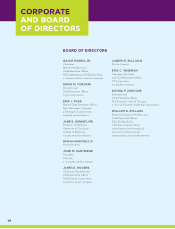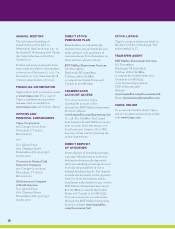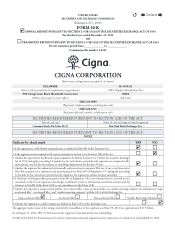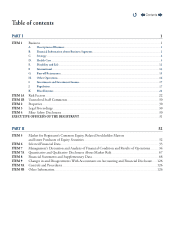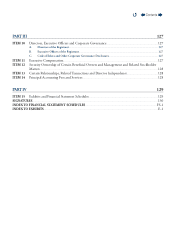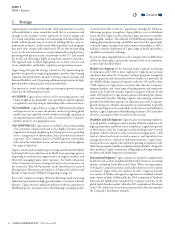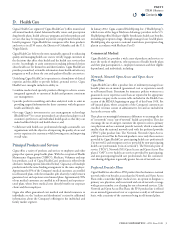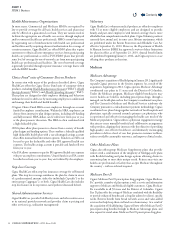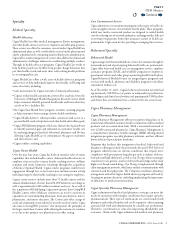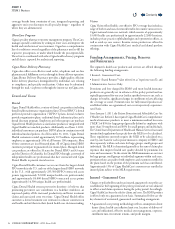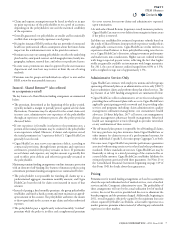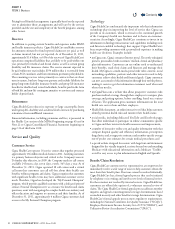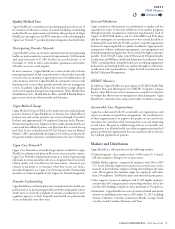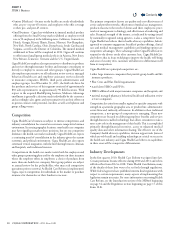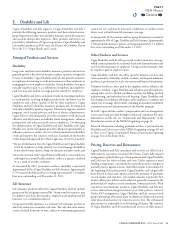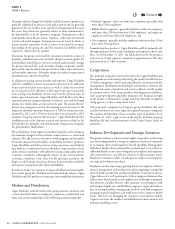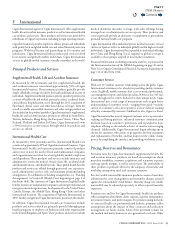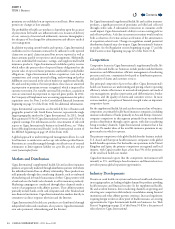Cigna 2011 Annual Report Download - page 26
Download and view the complete annual report
Please find page 26 of the 2011 Cigna annual report below. You can navigate through the pages in the report by either clicking on the pages listed below, or by using the keyword search tool below to find specific information within the annual report.
4CIGNA CORPORATION2011 Form10K
PARTI
ITEM 1 Business
Health Maintenance Organizations
In most states, Commercial and Medicare HMOs are required by
law to provide coverage for all basic health services and plans may
only be oered on a guaranteed cost basis. ey use various tools to
facilitate the appropriate use of health care services through employed
and/or contracted health care professionals. HMOs control unit costs
by negotiating rates of reimbursement with health care professionals
and facilities and by requiring advanced authorization for coverage of
certain treatments. Cigna HealthCare oers HMO plans that require
customers to obtain all non-emergency services from participating
health care professionals as well as POS HMO plans that provide
some level of coverage for out-of-network care from non-participating
health care professionals and facilities. e out-of-network coverage
is generally provided through separate insurance coverage that is sold
with the HMO benets.
Choice Fund® suite of Consumer-Driven Products
In connection with many of the products described above, Cigna
HealthCare oers the Cigna Choice Fund suite of consumer-driven
products, including Health Reimbursement Accounts (“HRA”), Health
Savings Accounts (“HSA”) and Flexible Spending Accounts (“FSA”).
ese plans are designed to shift employee thinking and behaviors
without the need to shift cost by motivating employees to understand
and manage their health and health benets.
•
Cigna’s Choice Fund HRA covers employees through an account
funded by employer contributions. Within the HRA, employers can
choose from innovative plan design options, including self-funding
and fully-insured. HRA dollars can be rolled over from year to year
at the plan sponsors’ discretion. e HRA is often combined with
a high deductible plan.
•
HSA plans allow plan sponsors to choose from a variety of benet
plan designs and funding options. ey combine a federally qualied
high deductible health plan with a tax-advantaged savings account
that oers mutual fund investment options. Funds in an HSA can
be used to pay the deductible and other IRS approved health care
expenses. e health savings account is portable and funds roll over
from year to year.
•
An FSA allows customers to pay for IRS approved health care expenses
with pre-tax employee contributions. Unused funds in an FSA cannot
be rolled over from year to year; they are forfeited by the employee.
Stop Loss Coverage
Cigna HealthCare oers stop loss insurance coverage for self-insured
plans. is stop loss coverage reimburses the plan for claims in excess
of a predetermined amount, either for individuals (“specic”) or the
entire group (“aggregate”), or both. Cigna HealthCare also includes
stop loss features in its experience-rated policies (discussed below).
Shared Administration Services
Cigna HealthCare provides Taft-Hartley trusts and other entities access
to its national provider network and provides claim re-pricing and
other services (e.g., utilization management).
Voluntary
Cigna HealthCare’s voluntary medical products are oered to employers
with 51 or more eligible employees and are designed to provide
hourly and part-time employees with limited coverage that is more
aordable than comprehensive medical plans. Cigna Voluntary products
currently have annual and, in some cases, lifetime maximums, which
are prohibited under the Patient Protection and Aordable Care Act
eective September23,2010. However, the Department of Health
& Human Services (HHS) has approved a waiver of these limitations
for plans in eect as of September23,2010. Annual benet limits
are prohibited beginning January1,2014, and Cigna expects to cease
oering these products at that time.
Medicare
Medicare Advantage
e Company’s acquisition of HealthSpring in January2012 signicantly
expands Cigna’s presence in the Seniors segment. As a result of the
acquisition, beginning in 2012, Cigna operates Medicare Advantage
coordinated care plans in 11 states and the District of Columbia.
Under the Medicare program, Medicare-eligible beneciaries may
receive health care benets, including prescription drugs, through a
managed care health plan such as the Company’s coordinated care plans,
and e Centers for Medicare and Medicaid Services reimburse the
Company pursuant to a risk adjustment payment methodology. Cigna’s
coordinated care plans bring together networks of local hospitals and
physicians, typically centered around a primary care physician, who
is experienced and eective in managing the health care needs of the
Medicare population. Cigna utilizes a physician engagement strategy
that aims to create mutually benecial and collaborative arrangements
with providers, aligning their interests with the objective of providing
high-quality, cost-eective healthcare, and ultimately encouraging
providers to deliver a level of care that promotes customer wellness,
reduces avoidable catastrophic outcomes, and improves clinical results.
Other Medicare Plans
Cigna also oers group Medicare Supplement plans that provide
retirees with a combination of the simplicity of Medigap-style plans
with exible funding and plan design options allowing clients to
customize plans to meet their unique needs. Retirees may visit any
health care professional or facility that accepts Medicare throughout
the country– with no referrals required.
Medicare Part D
Cigna’s Medicare PartD prescription drug program, Cigna Medicare
Rx®, provides a number of plan options as well as service and information
support to Medicare and Medicaid eligible customers. Cigna Medicare
Rx is available in all 50states and the District of Columbia. Cigna’s
PartD plans oer the savings of Medicare combined with the exibility
to provide enhanced benets and a drug list tailored to clients’ specic
needs. Retirees benet from broad network access and value-added
services that help keep them well and save them money. As a result of
the acquisition of HealthSpring, Cigna will now oer Medicare PartD
prescription drug benets through its Medicare Advantage plans, and
also expand its stand-alone Medicare PartD prescription drug plan.
Contents
Q


